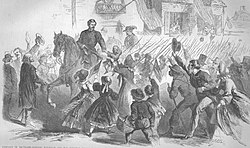George B. McClellan
George Brinton McClellan (December 3, 1826 – October 29, 1885) was a Major general in Union army during the American Civil War. In 1861 and 1862, he was in charge of the Army of the Potomac. He led the Peninsula Campaign, an attempt to take Richmond, Virginia that didn't work. Though he won the Battle of Antietam, he did not get along with President Abraham Lincoln, who fired him. After he stopped being a general, he became a politician, and ran against Lincoln in the 1864 election. He was later Governor of New Jersey, though he was originally from Pennsylvania. He was also a prominent engineer, and was offered the job as President of the University of California.
George B. McClellan | |
|---|---|
 1861 photograph by Mathew Brady | |
| 24th Governor of New Jersey | |
| In office January 15, 1878 – January 18, 1881 | |
| Preceded by | Joseph D. Bedle |
| Succeeded by | George C. Ludlow |
| Personal details | |
| Born | George Brinton McClellan December 3, 1826 Philadelphia, Pennsylvania |
| Died | October 29, 1885 (aged 58) Orange, New Jersey |
| Cause of death | Heart attack |
| Political party | Democratic |
| Spouse(s) | Mary Ellen Marcy ("Nelly") McClellan |
| Parents |
|
| Alma mater | United States Military Academy |
| Profession | Soldier (General) |
| Signature |  |
| Military service | |
| Nickname(s) | Little Mac The Young Napoleon[1] |
| Allegiance | United States of America Union |
| Branch/service | United States Army Union Army |
| Years of service | 1846–1857, 1861–1864 |
| Rank | |
| Commands | Department of the Ohio Army of the Potomac |
| Battles/wars | Mexican–American War American Civil War |
He was seen as slow and thought all his fights through, training his soldiers very long. He was too slow acting for Abraham Lincoln's taste, who fired him several times. Mrs. Lincoln despised him greatly, therefore an influence of Mr. Lincoln's decision.
George B. McClellan Media
The Julian Scott portrait of McClellan in the National Portrait Gallery in Washington, D.C.
Patriotic cover honoring the arrival of McClellan in Washington, D.C., on July 26, 1861
General George B. McClellan with staff & dignitaries (from left to right): Gen. George W. Morell, Lt. Col. A.V. Colburn, Gen. McClellan, Lt. Col. N.B. Sweitzer, Prince de Joinville (son of King Louis Phillippe of France), and on the very right—the prince's nephew, Count de Paris
"Quaker guns" (logs used as ruses to imitate cannons) in former Confederate fortifications at Manassas Junction
Federal troops under heavy attack at the Battle of Gaines's Mill, sketched by Alfred R. Waud and published in Harper's Weekly, July 26, 1862
Wounded men after the Battle of Savage's Station, one of the Seven Days Battles
An illustration of McClellan riding through Frederick, Maryland, September 12, 1862, from Frank Leslie's Illustrated Newspaper
References
- ↑ John H.Eicher; David J. Eicher, Civil War High Commands (Stanford, CA: Stanford University Press, 2001), p. 371.









